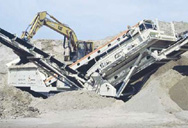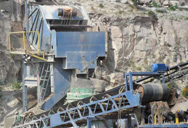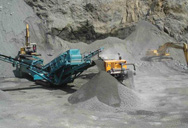


2020-1-2 Abstract— Hydrocyclone is a simple mechanical device, with no moving parts, where solid particles are separated from liquid with very little head loss. As its name describes, it uses a cyclone or tangential injection flow process enhancing the centrifugal forces and moving solids outwards. The dispersed particles, move downwards in a spiral path into an underflow chamber, while clean liquid move upwards to the center of the spiral, towards thetopoutlet. In this way, sand and other particles get separated
Read More
2015-10-12 Here is a hydrocyclone sizing calculator with immediate access to all design equations needed for your hydrocyclone design calculation in an online XLS spreadsheet format. Based on first principles of hydrocyclone theory and equations, this quasi design software lets you enter all cyclone design
Read More
The hydrocyclone separator is simplistic in design that uses pressure created by a centrifugal pump or hydrostatic head to generate centrifugal force and flow patterns within the hydrocyclone. It does not have any moving parts, but consists of an inlet section, vortex finder, cylindrical section, a conical section, an underflow spigot section and an overflow pipe.
Read More
Advantages of static hydrocyclone separators include: (1) they have no moving parts (thus, minimum maintenance and operator attention is required), (2)their compact design reduces weight and space requirements when compared to those of a flotation unit, (3) they are insensitive to motion (thus, they are suitable for floating facilities), (4) their modular design
Read More
This study considers the dynamic model of the rotating flow of a two-phase liquid into a hydrocyclone, and its influence on inherent particles. The geometrical parameters of rotating liquid flow, the relative movement of particles and their separation are described using specific properties of liquid and particles, the energy losses due to viscosity and processing requirements.
Read More
The VDF hydrocyclone separator offers a media-free solution to removing finely-sized suspended solid contaminants from liquids. Removes Aluminum, Copper, Bronze, Brass, Steel, Iron, and more. Clients using Nikuni's VDF cyclonic separators have enjoyed numerous HIGHLIGHTS: Precise Filtration Performance; Filter Ferrous AND Non-Ferrous Material
Read More
2016-10-17 HYDROCYCLONE SEPARATOR Hardware All hydrocyclones are composed of four (4) main sections: 1. Inlet The inlet section is comprised of a cylindrical feed chamber which serves to convert the incoming flow to a tangential flow with minimal turbulence. Critical design variables include the inlet area and inlet type. Smaller inlet sizes
Read More
2020-10-25 classify the particles. There are various design parameters of hydrocyclone which are as follows: Cone angle: For design purpose, 20 0 and 26 0 cone angles were chosen. Arterburn (1976) reported that the larger the hydrocyclone diameter, the coarser the separation. The included angle of the cone section is normally between 10 0 and 20 0. Cone section length:
Read More
There are two main designs of cyclone separator, these are the gas cyclone and hydrocyclone. Gas cyclones are used to remove entrained particles from a gas stream. Typical Gas Cyclone Installation Hydrocyclones are used for separating fluids of different densities.
Read More
2016-3-6 PROCESS DESIGN OF SOLID-LIQUID SEPARATORS (PROJECT STANDARDS AND SPECIFICATIONS) Page 3 of 34 Rev: 01 April 2011 x100 (w d) w F 2 o Eq. (2) Overflow - The stream being discharged out of the top of a hydrocyclone, through a protruding pipe, is called "overflow". This stream consists of bulk of feed liquid together with the very fine solids.
Read More
2017-10-30 Design of Hydrocyclone for Drilling Solid Separation. Fig. 1. Schematic diagram of the hydrocyclone. Hydrocyclone, as in Fig. 1, is the device that is widely used for the separation of materials normally in the form of solid particles. In drilling rig
Read More
2015-8-1 The main idea of three-phase hydrocyclone design is based on the geometry combination of two conventional hydrocyclone or combining with filtration, flotation, grit chamber and so on. Various types of three-phase hydrocyclone may be used for each other, but experiment and simulation are needed to get useful conclusions. 2.
Read More
2020-10-20 The ODIS hydrocyclone separator is a simple device, easy to operate and maintain. It has no moving ... with the proper functioning of the hydrocyclone • Modular design - suitable for use in arrays for various fl ow rates • 100 micron extra-durable polyester,
Read More
Hydrocyclone separators, sometimes called enhanced gravity separators, use centrifugal force to remove oil droplets from oily water. As shown in Figure 7-16, static hydrocyclone separator consist of the following four sections: a cylindrical swirl chamber, a
Read More
The VDF hydrocyclone separator offers a media-free solution to removing finely-sized suspended solid contaminants from liquids. Removes Aluminum, Copper, Bronze, Brass, Steel, Iron, and more. Clients using Nikuni's VDF cyclonic separators have enjoyed numerous HIGHLIGHTS: Precise Filtration Performance. Filter Ferrous AND Non-Ferrous Material.
Read More
2016-10-17 HYDROCYCLONE SEPARATOR Hardware All hydrocyclones are composed of four (4) main sections: 1. Inlet The inlet section is comprised of a cylindrical feed chamber which serves to convert the incoming flow to a tangential flow with minimal turbulence. Critical design variables include the inlet area and inlet type. Smaller inlet sizes
Read More
2020-10-25 hydrocyclone model M 3 with 26 0 cone angle and 0.065m underflow cylinder diameter was the best model with the removal efficiency of 95.68% among all the six models. Originally in the later part of the 19 th century hydrocyclone was used as a solid/liquid separator to remove sand from well water. A typical hydrocyclone
Read More
2016-3-6 PROCESS DESIGN OF SOLID-LIQUID ... DEFINITIONS AND TERMINOLOGY 2 SYMBOLS AND ABBREVIATIONS 3 UNITS 4 GENERAL 4 Solid-Liquid Separator Types 4 Separation Principles 5 LIQUID FILTERS 6 General 6 Filter Selection 11 CENTRIFUGES 18 General 18 Selection of Centrifuges 19 HYDROCYCLONES 22 General 22 Hydrocyclone Size Estimation 22 APPENDIX A 25 ...
Read More
In principle, the hydrocyclone is a solid bowl centrifuge of “slim” design. lt can be compared to a high-speed tubular centrifuge but also with a long-tube decanter. In the case of the hydrocyclone, however, the body is stationary. A rotation is initiated by the
Read More
1997-12-5 The Impact of Micron Removal Efficiency on Oil/Water Separator Design. Determining the micron removal efficiency required to meet your effluent requirements (ppm, mg/l) is an important step in the design and sizing on oil water separators. A small change in the micron removal efficiency can result in a large change in the size of the specified ...
Read More
2017-10-30 Design of Hydrocyclone for Drilling Solid Separation. Fig. 1. Schematic diagram of the hydrocyclone. Hydrocyclone, as in Fig. 1, is the device that is widely used for the separation of materials normally in the form of solid particles. In drilling rig
Read More
2020-10-20 The ODIS hydrocyclone separator is a simple device, easy to operate and maintain. It has no moving ... with the proper functioning of the hydrocyclone • Modular design - suitable for use in arrays for various fl ow rates • 100 micron extra-durable polyester,
Read More
2016-10-17 HYDROCYCLONE SEPARATOR Hardware All hydrocyclones are composed of four (4) main sections: 1. Inlet The inlet section is comprised of a cylindrical feed chamber which serves to convert the incoming flow to a tangential flow with minimal turbulence. Critical design variables include the inlet area and inlet type. Smaller inlet sizes
Read More
hydrocyclone separator design calculation. Here is a hydrocyclone sizing calculator with immediate access to all design equations needed for your hydrocyclone design calculation in Get price. Separator sizing – Hydrocyclone Separator. Separator sizing
Read More
2021-6-19 Hydrocyclone. +8613879771862. sales@jxscmining. Inquire Now. Hydrocyclones first appeared in dutch in the late 1800s, Hidrociclon is an equipment that uses rotary current to classify, separate or sort coarse particles of sewage. It widely used in mine processing such as aggregates, hard rock mining, sand, industrial minerals, coal and more.
Read More
A reverse flow cyclone separator is an industrial assembly with no moving parts and a simple design. The main cylindrical part of the cyclone separator is known as the body or barrel. The gradually narrowing conical section is known as the cone. Un-treated gas enters tangentially through the inlet at the side of the separator.
Read More
2019-1-4 Separator design and implementation. The terms ‘separator’ and ‘hydrocyclone’ describe the same general type of solids/liquid separation device. While the term separator is often used to describe both types of equipment, there is a technical difference between the two.
Read More
2016-5-14 Design and analysis of cyclone dust separator 1Muhammad I. Taiwo . 2Mohammed A. Namadi. and 3James, B. Mokwa 12 Department of Mechanical Engineering, Kaduna polytechnic, Kaduna. 3 Department of Mechanical Engineering, Federal Polytechnic Bida ABSTRACT: Cyclones have often been regarded as low-efficiency collectors. However, efficiency varies ...
Read More
The Cavex ® hydrocyclone design delivers maximum efficiency, maximum hydraulic capacity and long wear life. The laminar spiral inlet geometry design provides a natural flow path into the Cavex ® hydrocyclone. Its unique shape has no sharp edges or
Read More
1997-12-5 The Impact of Micron Removal Efficiency on Oil/Water Separator Design. Determining the micron removal efficiency required to meet your effluent requirements (ppm, mg/l) is an important step in the design and sizing on oil water separators. A
Read More
